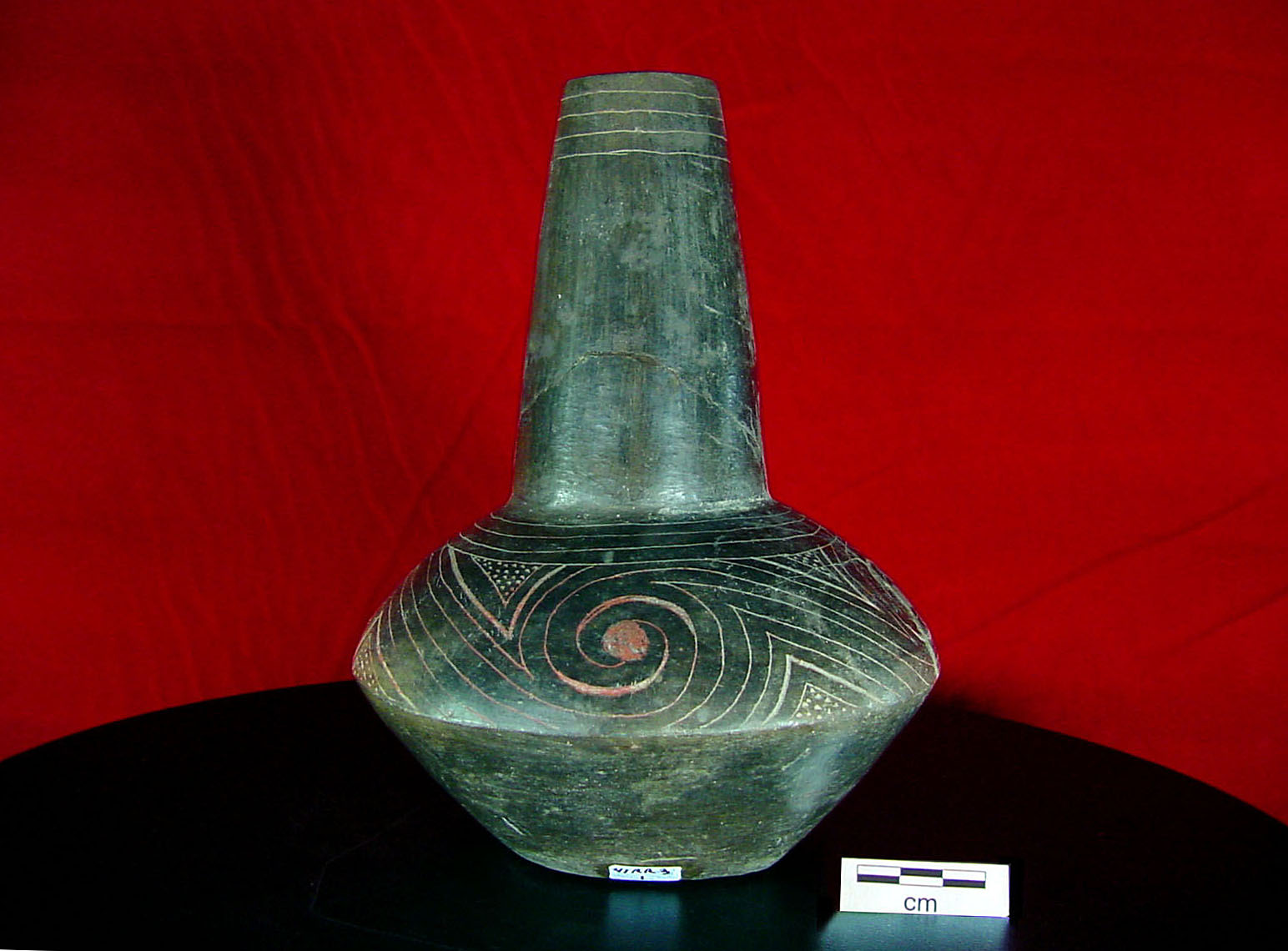
Object: Spiro Engraved pottery
Date: ca. AD 1000-1200, Early Caddo period
Context: Caddo Homeland, Pineywoods, Northeast Texas, Mustang Creek Mound site
Amongst the most iconic of the ceramic vessel types made by ancestral Caddo master potters in the Caddo Homeland of northeast Texas and adjacent states is what archeologists have called Spiro Engraved pottery. The bottle form is especially distinctive having a tall conical neck and graceful concentric circles, nested arcs, spirals, or squares, repeated usually four times around the vessel body. Spiro Engraved embodies ethnologist John Swanton´s appraisal that “in Caddo ceramics the art of the Southeast easily reaches its apex.”
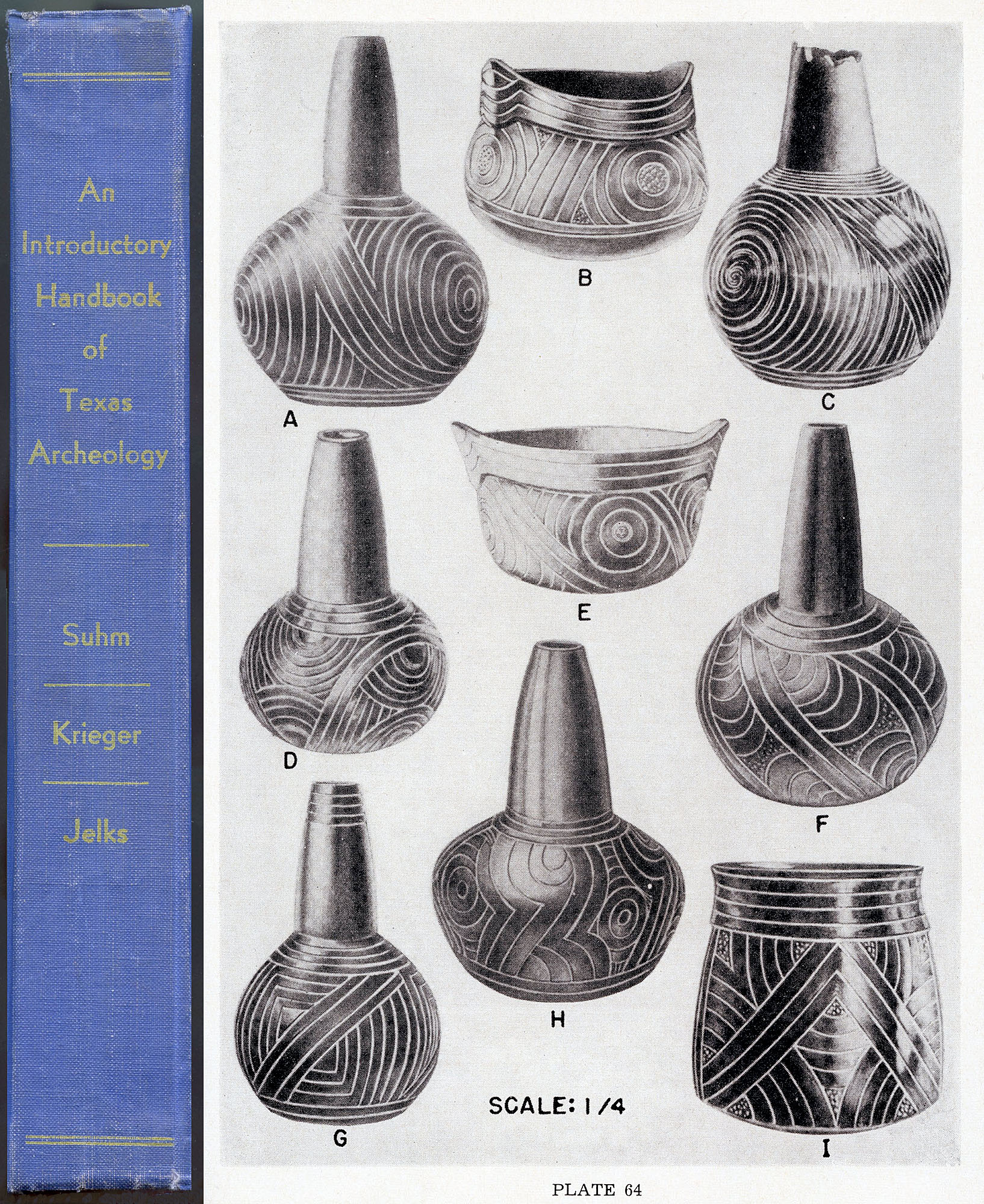
Elsewhere on TBH readers will find interwoven exhibits on the theme Tejas: Life and Times of Caddo providing an intimate look at the Caddo's long and distinguished history. Over thousands of years ancestral Caddo societies of farmers, warriors, potters, priests, and traders flourished across the valleys and tributaries of the Ouachita, Red, Sabine, and Neches rivers in what is today northeast Texas, northwest Louisiana, southwest Arkansas, and southeast Oklahoma. Especially relevant here is the Tejas exhibit Created in Clay which showcases the extraordinary Caddo pottery tradition.
Spiro Engraved was first recognized as a distinctive type by archeologists in Oklahoma and Texas in the 1940s and formally defined in 1954 by Suhm and Krieger in An Introductory Handbook of Texas Archeology. All of the whole (or reconstructed) vessels used to illustrate the type in the Handbook came from Craig Mound at the namesake Spiro site. Spiro Engraved was long thought to have been made and used by communities throughout the greater Caddo area, including the Arkansas River basin in eastern Oklahoma (the Northern Caddo area), where Spiro site is located (see Spiro and the Arkansas Basin). However, recent archeological studies (including instrumental neutron activation analyses pinpointing manufacturing location) have shown that Spiro Engraved vessels were made only in the Southern Caddo area (or Caddo Homeland) especially along the Red River and its tributaries (see Caddo Homeland: the Land and its Resources). In other words, the Spiro Engraved bottles, bowls, and jars found in Craig Mound were likely made 100 miles or more to the south.
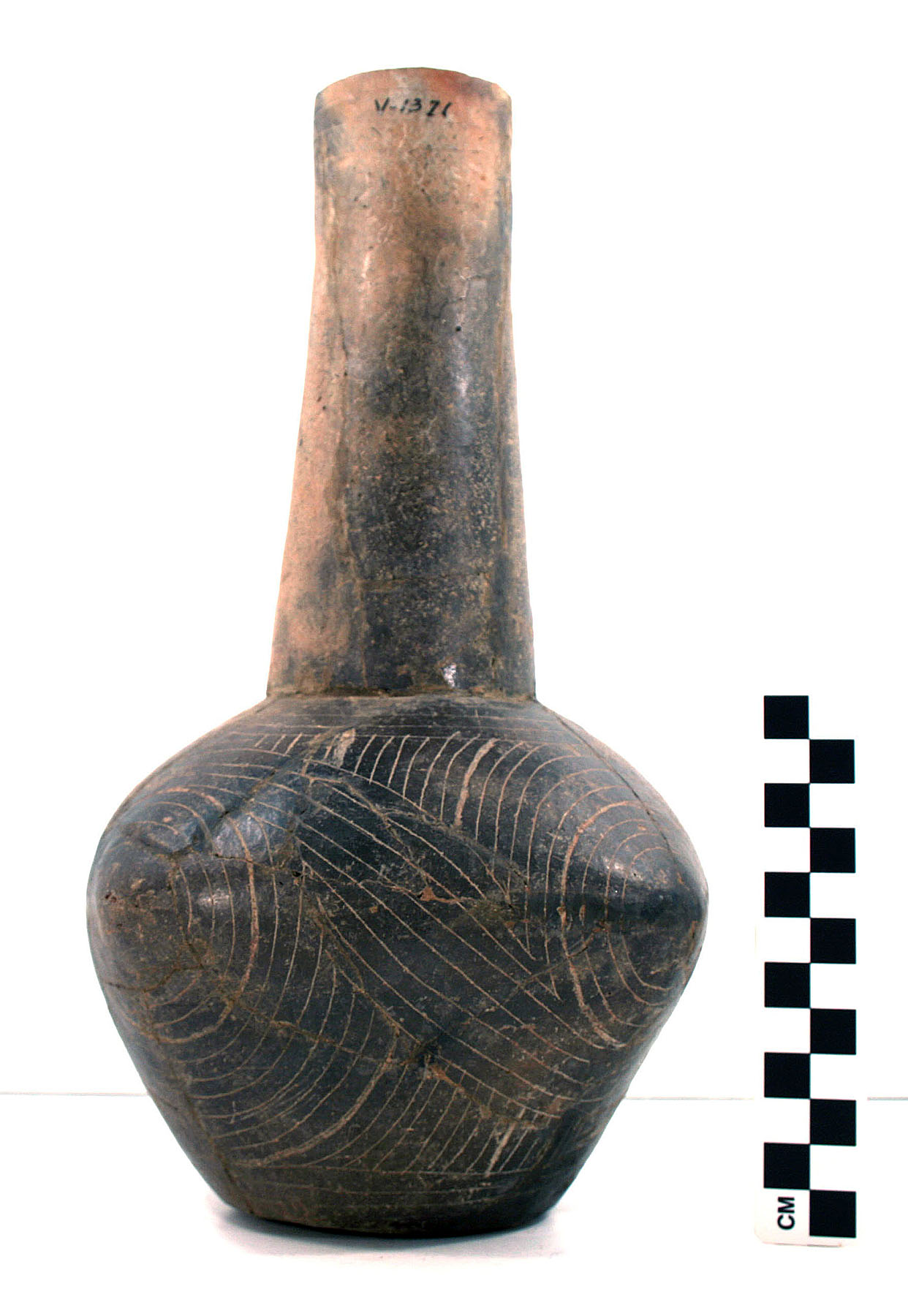
Thus, "Spiro" Engraved is a geographic and cultural misnomer. This distinctive pottery type warrants a renaming that reflects its production in the Southern Caddo area that "would reflect Caddo culture or history," as modern Caddo potter Jeri Redcorn put it. Archeologists are currently working with representatives of the Caddo Nation of Oklahoma on the renaming of this type.
Although pottery was made and used in almost every Caddo community throughout the Caddo world, few Caddo potters had the skill or knowledge to make Spiro Engraved pottery. The pottery makers in each ancestral Caddo community were women who passed along their knowledge and designs to their daughters and granddaughters. Most Caddo pottery was sturdy utilitarian coarse ware made for everyday use as cooking, storage, and serving vessels (see Making Caddo Pottery). In contrast, Caddo fine wares were made to be admired using fine temper which allowed thinner walls and well-finished exteriors that were decorated in many creative ways, showing artistry and honoring tradition.
Spiro Engraved stands out among Caddo fine wares as particularly well-made pottery that only a master potter was capable of creating. The expert potters who made this very fine ware followed very specific steps not only in the manufacture of the bottles, but also the exact sequence in which engraved lines were executed on vessels. Engraving is a form of decoration that is accomplished after the basic ceramic vessel has been fired and burnished. A hard, sharp tool such as a flint flake was used to cut through the burnished surface to create slightly rough-edged lines and patterns.
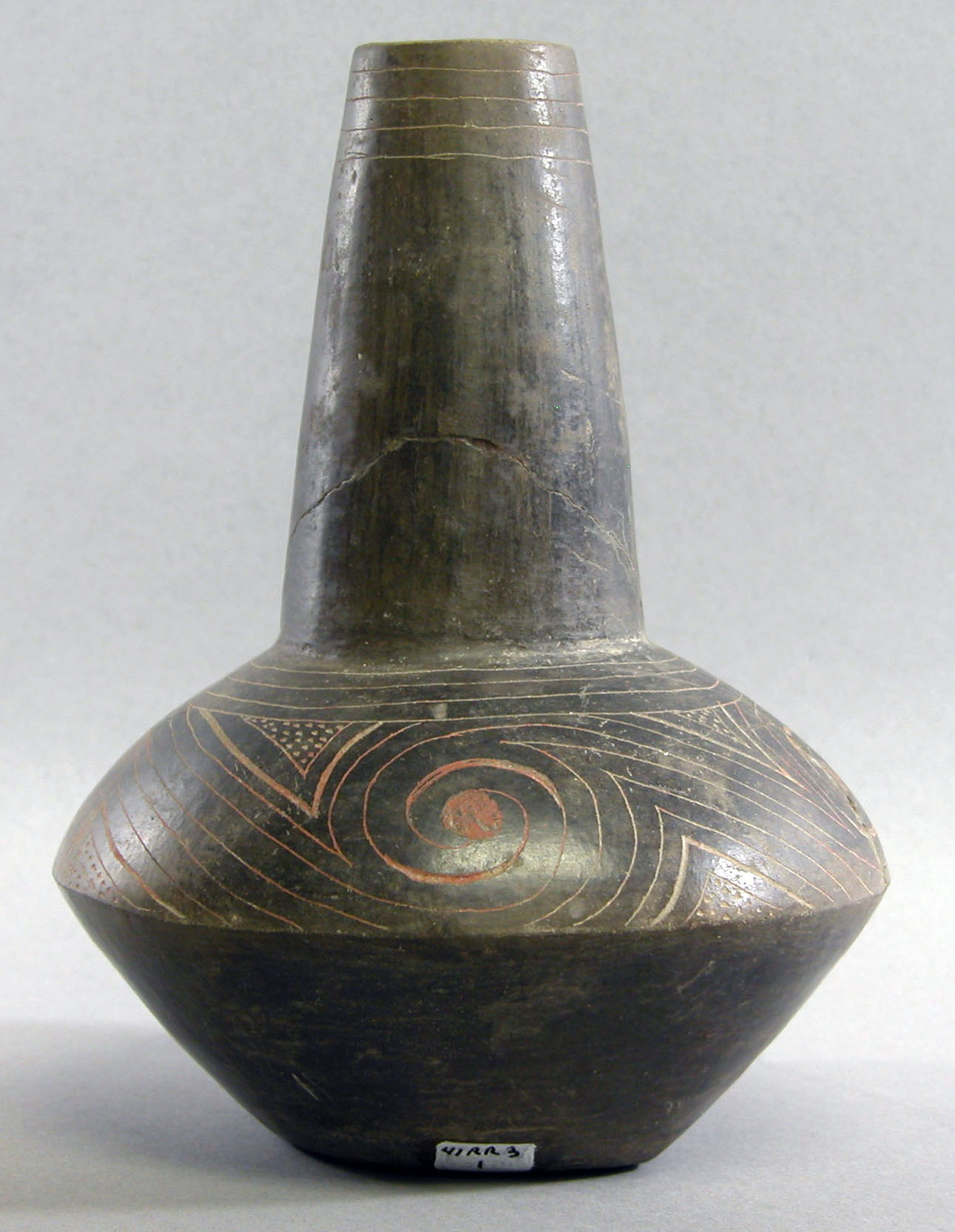
Vessel 1 from the Mustang Creek Mound site (41RR3) is a burnished carinated bottle of the Spiro Engraved type. The bottle has a square and flat base, and stands 19.0 cm (7.5") in height, with a neck orifice diameter of 3.7 cm (1.3"); the maximum body diameter is 14.5 cm (5.7"). The long and slightly tapered neck has four horizontal engraved lines below the lip, as well as at the top of the vessel body. By closely examining the depth and overlap of engraved lines on this vessel using archaeologist Shawn Lambert's "design stratigraphy" approach, one can reconstruct the engraving sequence or "design pathway."
The finely engraved bottle featured in this TBH Gallery entry is one of several Spiro Engraved vessels that were recovered from the Mustang Creek Mound site, an Early Caddo (ca. A.D. 1000-1200) burial mound constructed by Caddo peoples on a tributary to the Sulphur River in East Texas. The site, also known as the T. N. Coles site, was never investigated by a professional archeologist, but A. T. Jackson of the University of Texas visited the site in 1931, not long after landodwner Tom N. Coles had dug into the center of the mound and found a large burial pit or tomb. This feature contained multiple interred individuals, including at least two ancestral Caddo individuals with cranially modeled or modified skulls, marking high social status. Found associated with these individuals were a number of ceramic vessels, two conch shell beads, fragments of hammered sheet copper, and a large chipped knife (i.e., a Gahagan biface). This prominent grave at the Mustang Creek site is very similar to Early Caddo period shaft tombs at the Gahagan and Mounds Plantation sites on the Red River in Northwest Louisiana, the Crenshaw site on the Red River in Southwest Arkansas, and the George C. Davis and Boxed Springs sites on the Neches and Sabine rivers in East Texas.
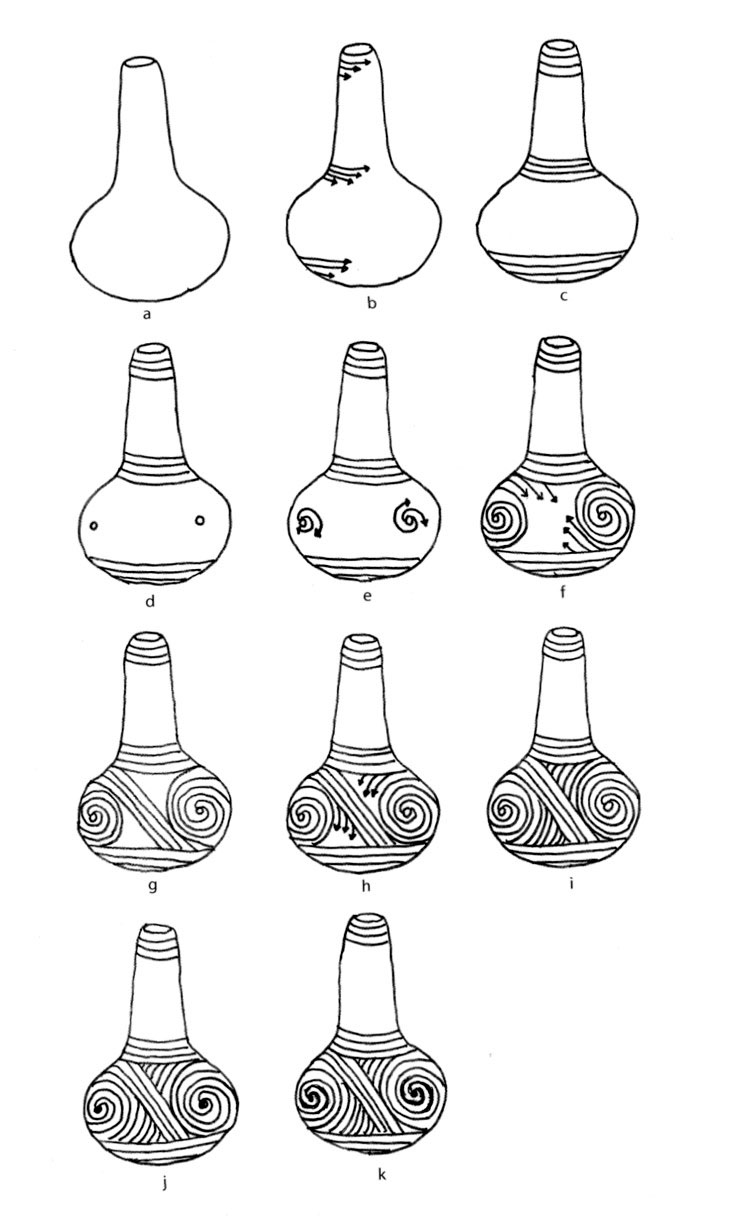
The Spiro Engraved design pathway began with the engraving of four lines around the bottle neck. The remainder of the vessel's carinated body has fine engraved lines in concentric spirals—with some lines engraved deeper than others—and parallel straight or diagonal lines running at different angles; these are the second step in the decoration of the vessel. The third step in completing the design is adding the central element: the center of the spirals have prominent excised circles, and there are wider excised areas on the first or second spirals opposite the excised circles, but these were done to enhance the spirals. Finally, the fourth design step includes adding above and beneath the spirals four sets of triangular zones filled with small excised or carved out punctations.
A red hematite-rich clay pigment has been rubbed in some of the engraved spirals as well as the excised central elements. According to Bobby Gonzalez of the Caddo Nation of Oklahoma "the red pigment means life and is very sacred among the Caddo. The red pigment is now used on peyote staffs, and during ritual ceremonies and prayer meetings, the red pigment is painted on and in the ears as well as on the top of the head in the middle of a man's hair line, running from front to back; the women and men paint themselves in the morning when the sun comes up" (2008 personal communication). Ancestral Caddo peoples bathed the deceased in red clay, and in historic times red was used as a paint or pigments on material items in ceremonies. Therefore, this Spiro Engraved vessel with a red pigment likely is a vessel that symbolizes life and its sacredness to the Caddo. It is possible that the red pigment may have been ritually applied to the vessel shortly before it was placed in the grave with the deceased.
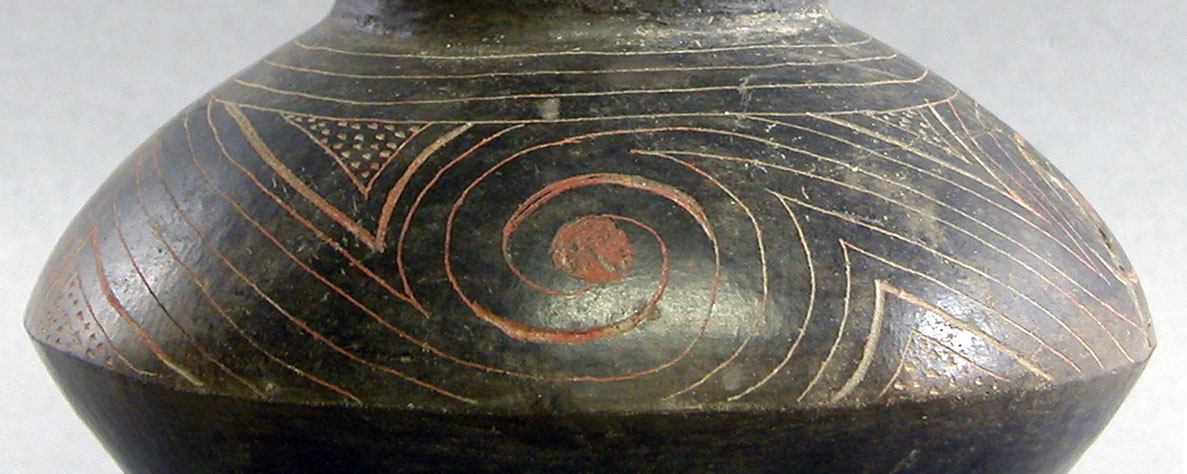
The range of funerary offerings in the central grave at the Mustang Creek Mound site suggests that it was clearly associated with the death and interment of important religious or political individuals and leaders in the local Sulphur River Caddo community, as is the case at a number of burials and tombs in Early Caddo mound centers in much of the southern Caddo area. These offerings were meant to accompany the dead on their journey to the "House of Death in the Sky." The Spiro Engraved bottle likely held a beverage to help sustain the departed on the six-day journey.
Credits
Written by Tim Perttula.
Print Sources
Lambert, Shawn P.
2021 A Provenance and Stylistic Study of Early Caddo Vessels. In Ancestral Caddo Ceramic Traditions. edited by Duncan P. McKinnon, Jeffrey S. Girard, and Timothy K. Perttula, pp. 157-172. Louisiana State University Press, Baton Rouge.
Redcorn, Jeri
2021 Caddo Pottery: Connecting with My Ancestors. In Ancestral Caddo Ceramic Traditions. edited by Duncan P. McKinnon, Jeffrey S. Girard, and Timothy K. Perttula, pp. 279-289. Louisiana State University Press, Baton Rouge.
Suhm, Dee Ann and Alex D. Krieger, with the collaboration of Edward B. Jelks
1954 An Introductory Handbook of Texas Archeology. Bulletin of the Texas Archeological Society 25.